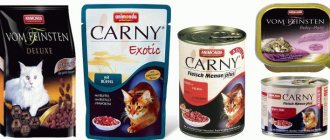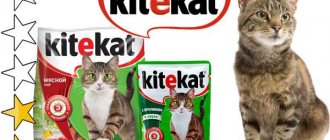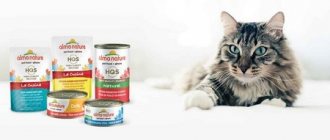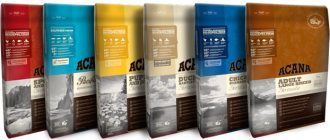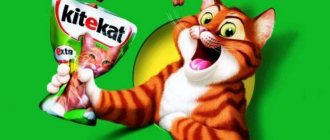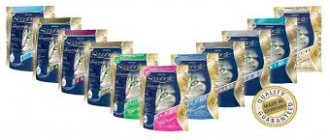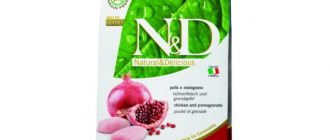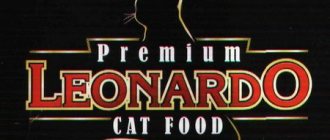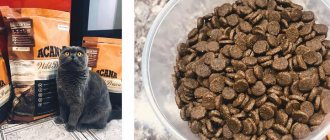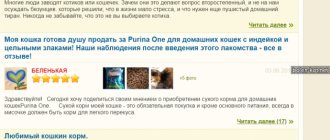What will you learn from the article?
- Types of cat food Kitekat
- Compound:
- Which position should you choose for your pet?
- Reviews of Kitiket cat food
- Conclusion
What should you buy your beloved pet to eat? Maybe Kitiket cat food? Let's look at the composition of this food, find out the opinions of experts and those who have already had experience feeding kitite to their cats. So, is it worth giving Kitekat to your animal as a regular food?
Types of cat food Kitekat
Dry food of this brand is presented in standard packaging of 0.4 kg, 1 kg, 10 kg, 13 kg.
Wet food is sold in packs of 85 grams, and in canned food weighing 400 grams.
As practice has shown, the majority of animals that constantly consumed this food:
- don't look good
- lose their fur
- suffer from colic and vomiting,
- have trouble going to the toilet
- get sick with urolithiasis and other serious diseases,
- die.
However, there are also positive reviews about Kitiket food for cats, which are explained by the characteristics of the animal’s body or the fact that it is not yet sufficiently “saturated with vitamins” that are included in the food. The composition, as many say, leaves much to be desired, especially since some of its contents are “cunningly hidden” by the manufacturer.
Wet diet
Small bags of a convenient format, measuring 140 x 95 mm, contain a portion of wet food sufficient for a single meal for an adult cat. The composition of the food is balanced in terms of the content of essential nutrients and complies with accepted standards for a cat’s diet.
Wet diet
The main advantage of canned food is that this food is more nutritious and high in calories, is easier to digest than dry food, and cats get more moisture with it.
The composition includes: meat and offal (at least 4%), cereals, taurine, vitamins and minerals necessary for the animal’s body. It is recommended to give cats weighing up to 4 kg – 400 g (4-5 pcs. bags) per day, pregnant and lactating women – 600-800 g (7-9 pcs.)
Compound:
- Meat and products of animal origin, which include only waste of animal origin: beaks, feathers, tendons, heads, hooves;
- Flour from chicken by-products and fish;
- Corn gluten;
- Corn;
- Mineral supplements;
- Vitamin supplements;
- Carbohydrates;
- Rice;
- Wheat flour;
- Salt;
- Preservatives and dyes;
- Natural flavors;
- Taurine, calcium carbonate, potassium iodide, dried brewer's yeast, methionine, sulfates (manganese, copper, zinc)…
So, as you can see, the composition is far from ideal. There is a lot in food that is harmful to animals:
- wheat flour and yeast are allergens,
- preservatives are “slow poison”,
- offal meal is animal waste that is not beneficial for cats.
It will be interesting:
- reviews from veterinarians about Royal Canin food;
- all about Sheba cat food;
- about Bozita food.
The composition in percentage terms raises a lot of doubts and questions , since proteins - 30%, fiber - 5%, fats - 12%, moisture - 12%, other - 41% (what is this other?) In dry and wet food it is obvious There are substances that are addictive in cats. If everything in the food was really natural, then its price (200 rubles per 1 kg of dry food or 80 hryvnia) would not be so low. In addition, the fact that cats, like drug addicts, constantly want this food, eating it with incomprehensible delight, preferring it even to pure meat and other human “delicacies”, raises doubts - why?
Dry diet
Kiteket dry food consists of multi-colored granules of various tastes. You can purchase it in packages of 15 kg, 1.9 kg, 800 g and 350 g.
Dry diet
The feed includes: cereals and their processed products, animal flour (from animals and poultry), animal products, animal fat, protein plant components, vegetables and their processed products, sunflower oil, taurine, choline chloride methionine, minerals and vitamin complex.
Per 100 g of dry food there is:
- Protein – 28 g;
- Fat – 10 g;
- Fiber – 5 g;
- Ash – 9 g;
- Calcium – 1.5 g;
- Phosphorus – 0.9 g;
- Vitamin A – 1200 IU;
- Vitamin D – 120 IU;
- Vitamin E – 5.5 mg.
Energy value (100 g): 340 kcal/1422 kJ.
Important! Do not let the food sit in the bowl for several days, as it may spoil. Replace it with fresh one regularly.
The amount of food recommended per day is determined by the weight of the adult cat. For a cat weighing from 2 kg – 40 g, from 3 kg – 55 g, from 4 kg – 65 g, from 5 kg – 75 g. With a mixed type of feeding for an animal weighing from 2 kg - 20 g of dry food + 1 bag of wet food, from 3 kg - 30 g of granules + 1 bag, from 4 kg - 45 g + 1 bag, from 5 kg - 55 g + 1 bag . It is recommended to store it at temperatures from +4 to +35C and relative humidity up to 75%.
Which position should you choose for your pet?
We are forced to admit right away that we did not find reliable information about the composition of Kitiket feed. On the official Russian-language website of the brand https://www.kitekat.ru/ the manufacturer exclusively praises its products in general terms. Therefore, the most we can do for you is to list the taste rations of Kitekat food.
Dry food:
- Meat feast
- Assorted chicken and turkey
- The chicken is delicious
- Fisherman's catch
- Veal is delicious
Wet food:
- Juicy pieces with beef and carrots in jelly
- Juicy pieces with fish in sauce
- Juicy pieces of beef in sauce
- Juicy pieces of beef in jelly
- Juicy pieces with chicken in jelly
- Simple and delicious with chicken
- Simple and delicious with beef
- Homemade lunch with rabbit
- Homemade lunch with fish
- Homemade beef dinner
There are no medicinal, specialized or dietary lines under the Kitiket brand.
Pros and cons of food
By objectively assessing any product, experts identify the positive and negative qualities of the product. But it is necessary to understand that all characteristics are relative - the disadvantages of the food are not critical, but only indicate to the manufacturer what could be improved or added.
As a rule, the final list of criteria is formed by the experience of buyers and reflects their view of Kiteket products.
Kitekat feeds have proven themselves to be good. But, like any product, they have their positive and negative sides.
Pros: Cons:
Reviews of Kitiket cat food
Vladimir : “If there is a negative rating of food, then it is headed by Kitiket. A rare thing. It’s just a pity that you come to understand this through sad experience. Our cat ate kitite for three years. And then, at one point, urolithiasis appeared and he was gone in a few weeks, despite treatment, IVs, and expensive medications. Today I’m ready to stand with a banner near pet stores - PEOPLE, DON’T POISON YOUR PETS WITH THIS CRAP!”
Inga : “I’m ready to argue with those who pour buckets of dirt on Kitiket - people, you simply do not follow the rules of feeding ready-made food. Get your vaccinations on time, take care of worms and fleas, and don’t forget about easy and constant access to water and everything will be fine! We feed our cat kitite from birth and every six months we always take it to the veterinarian, where we take a blood test. The cat is 5 years old and everything is fine!”
Lyudmila : “My review is a warning. I would never believe that just food could cause rabies in a cat. No, this is not the classic rabies for which vaccinations are given, this is some kind of breakdown of the nervous system, when a cat really runs all over the furniture, walls, curtains and ceiling day and night without a break! As soon as you change the food, the cat becomes the same – playful, affectionate and calm. I don’t want this cruel circus to happen again!”
Benefits and harms for the animal
The benefit is that the cat receives a balanced diet, which does not cost its owners too much. For example, in animal shelters, inexpensive commercial food is a lifesaver for many homeless cats. The main disadvantage of economy class feed is the not very good quality of the raw materials and many artificial additives. You can find a large number of negative reviews from owners and veterinarians about Kiteket dry and wet food. The pet's reaction to it can be instantaneous, expressed in complete rejection and unwillingness to eat. Or have a cumulative negative effect extended over time, when side effects from the additives contained in the food result in some kind of chronic disease of the animal.
By buying economy class food for little money, you risk spending money on treating your pet in the future. Since cheap food can cause allergies, diseases of internal organs and urolithiasis in animals. Choose food based on the characteristics of the cat’s breed, first consult with your veterinarian.
Conclusion
The advantages of this food include its price, availability and variety, but its composition and effect on the animal are completely negative. If you ask a question on the Internet and look at the reviews of veterinarians who have experience in saving cats that have become ill due to eating this food, you will see many negative suggestions.
And reviews of Kitekat cat food are generally negative: angry cat owners literally curse unscrupulous manufacturers. So learn how to wean your cat off cheap food.
It’s up to you to decide whether to feed Kitiket or not, but remember the majority of negative reviews, and if you yourself gave this food to a cat, then tell us about your experience...
Reviews from veterinarians about Kitekat
You can have different attitudes to the reviews left by the owners: after all, the selection of food is a very individual matter. But it’s not easy to challenge the reviews of nutrition experts - here those who know exactly what food should form the basis of your furry’s diet get down to business. We have collected several reviews from veterinarians who shared their opinions about the Kitekat food lines.
Having extensive experience behind me, I can say one thing: ideal food simply does not exist. Any bag, even at a huge price, may simply not suit your pet, because their digestion and body characteristics are different. However, if we look at the facts about the basics of cat nutrition, we can draw a simple conclusion - Kiteket food has a fairly balanced composition and can be the main diet for every day.
Nutritional value, the presence of a satisfactory protein content, fats, grains and vitamins in the composition - all this ensures the high nutritional value of these diets. R. Solomonova, veterinarian
At work I heard a lot of reviews about economy class food. First of all, I note that the division into classes is quite incorrect, especially considering that the division is made by price category.
For example, Kitekat food, despite its low cost, is characterized by a composition that meets existing pet nutrition standards. After analyzing the ingredients, we can say that this food cannot harm your health. However, it is able to maintain the pet’s health and immunity, which means it can be recommended on a permanent basis. I. Reutova, veterinarian
Reviews from experts
Dmitry Olegovich Abanasimov, 25 years of experience: “I am one of the representatives of the “old veterinary school”, one of those who are against ready-made food as such. If you get a cat, then be kind enough to feed it like a real member of the family, and not get rid of it with a semi-finished product. Most health problems are caused by cheap ready-made food. Kitekat, Whiskas, etc. – these foods are one of the most disgusting options for feeding an animal. Every second cat owner, who prefers to save on food and buy cheap food, then turns to me for diagnostics of the animal’s genitourinary system. And, as a rule, pets have diseases in this particular area. Problems with the urinary system are quite difficult to treat and not always, so as a specialist I do not recommend feeding a cat such food.”
Yana Aleksandrovna Popova, 11 years of experience : “Since clients come to me with different incomes and can afford different pet foods, I often recommend periodically changing the pet’s diet. If the owner cannot afford to constantly feed the cat expensive food (for example, Arden Grange), then periodically it is permissible to replace it with a cheaper option. I do not recommend, but I do allow feeding Kitekat food for a short period of time. Nothing bad will happen. The main thing I would like to remind everyone is that when feeding your pet dry food, do not forget to always leave him access to the sippy cup. A cat needs more water than when fed natural food or wet food.”
Rashid Demidovich Doguzov, 19 years of experience: “I consider Kitiket to be low quality food and recommend avoiding it. But, if you do not have the opportunity to purchase other food, then it is better to give preference to wet food in pouches. It has a less harmful effect on the animal's gastrointestinal tract than dry crackers. But do not forget that you need to store it correctly. Approximately 70% of poisonings occur due to improper storage of leftover feed. Pay special attention to this."

